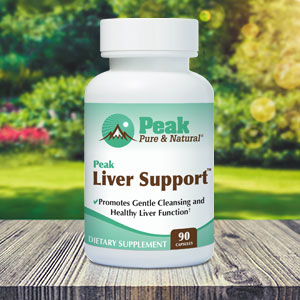Get Easy Health Digest™ in your inbox and don’t miss a thing when you subscribe today. Plus, get the free bonus report, Mother Nature’s Tips, Tricks and Remedies for Cholesterol, Blood Pressure & Blood Sugar as my way of saying welcome to the community!
How to save a fatty liver before it’s too late

We all know that we would die without a functioning heart.
But many people aren’t aware that the liver, the body’s largest solid organ, is just as crucial to life and health.
It’s the liver that detoxifies the body. It processes and gets rid of unwanted substances that enter your body through your lungs, skin or mouth. These include:
- Food additives
- Household chemicals
- Environmental pollutants
- Medications
- Hormones
Without your liver, all the vitamins you take in through food and supplements would be useless. That’s because your liver produces bile, which is necessary to break down those nutrients so your body can utilize them.
The liver stores blood sugar and breaks down fat, giving you energy to get through the day. It’s also responsible for blood clotting.
Needless to say, everything your liver does for you is vital, not just for good health, but to keep you alive and kicking.
That’s why we’re so excited to learn about a new study on how to prevent a silent liver disease that’s attacking more than 100 million Americans, according to the National Liver Foundation.
The dangers of a fatty liver
Nonalcoholic fatty liver disease (NAFLD) is a condition where fat accumulates in the liver.
Left untreated, NAFLD can progress to nonalcoholic steatohepatitis (NASH), which in turn can lead to cirrhosis, liver failure and liver cancer. At this point, a liver transplant may be the only way to save a life.
Some scientists feel the name metabolic associated fatty liver disease (MAFLD) more accurately reflects the disease, as knowledge gained from the past decades has convincingly demonstrated that MAFLD is a purely metabolic disorder. For example, there appears to be a connection to insulin resistance.
But regardless of whether you call it NAFLD or MAFLD, one thing is certain: It’s reversible.
Obesity has always been considered a risk factor as well, and so weight loss has been a primary prevention strategy, along with exercise to reduce excess belly fat.
But a recent study shows that participation in aerobic exercise and greater physical fitness alone could be more important than weight loss in reducing fat in the liver, to either prevent or treat disease progression.
Study shows improvement with aerobic exercise alone
While ultrasound and other non-invasive methods have been used in the past to measure the effect of exercise on liver fat content, a research team from Trinity College in Dublin has gone a step further.
Their study has been the first to relate improvements on liver biopsies with improvements in fitness, in the absence of any weight loss.
As opposed to less invasive techniques, a liver biopsy is considered the gold standard for diagnosing and assessing the state of the liver.
Twenty-four patients diagnosed with MAFLD took part. Sixteen of them undertook a 12-week aerobic exercise program, while eight became the control group.
Biopsies at the beginning of the study, and then at 12 and 52 weeks after the exercise program was completed, confirmed that the exercisers showed significant improvement in scarring and swelling of liver cells.
Exercise improves and prevents MAFLD
Dr. Philip O’Gorman, one of the study’s lead authors, expresses concern that long-term exercise interventions are not readily available to patients in their communities.
“The benefits of exercise training on both liver and cardiometabolic outcomes for these patients is very clear. Our findings suggest that there is an urgent need to better transition exercise into the community setting for these patients as the benefits of exercise intervention were not sustained longitudinally.”
In other words, without continued aerobic exercise, MAFLD worsened in these patients.
What does this mean for you?
If you already suffer from fatty liver disease, talking to your doctor about a regular program of aerobic exercise, one that you can sustain, could be a first step toward slowing the disease’s progress.
If, on the other hand, your liver is still healthy, regular aerobic exercise can help keep it that way.
Diabetes, steroid use and high cholesterol, as well as these nine other things, are all risk factors for fatty liver. If any of these are true for you, it would be wise to talk with your doctor about prevention now and head it off before it starts.
Editor’s note: There are perfectly safe and natural ways to decrease your risk of blood clots including the 25-cent vitamin, the nutrient that acts as a natural blood thinner and the powerful herb that helps clear plaque. To discover these and other secrets of long-lived hearts, click here for Hushed Up Natural Heart Cures and Common Misconceptions of Popular Heart Treatments!
Sources:
- Aerobic exercise could have the final say on fatty livers — Medical Express
- Improvement in histological endpoints of MAFLD following a 12‐week aerobic exercise intervention — Alimentary Pharmacology and Therapeutics
- nonalcoholic fatty liver disease — The Mayo Clinic














